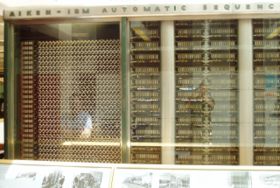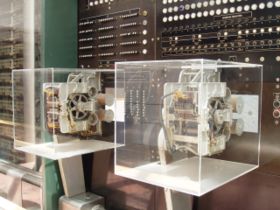Harvard Mark I
From Wikipedia, the free encyclopedia
The IBM Automatic Sequence Controlled Calculator (ASCC), called the Mark I by Harvard University,[1] was the first large-scale automatic digital computer in the USA. It is considered by some to be the first universal calculator.
The electromechanical ASCC was devised by Howard H. Aiken created at IBM, shipped to Harvard in February 1944, and formally delivered there on August 7, 1944. The main advantage of the Mark I was that it was fully automatic—it didn't need any human intervention once it started. It was the first fully automatic computer to be completed. It was also very reliable, much more so than early electronic computers. It is considered to be "the beginning of the era of the modern computer"[2] and "the real dawn of the computer age".[3]
Contents[hide] |
[edit] Design and Construction
The building elements of the ASCC were switches, relays, rotating shafts, and clutches. It was built using 765,000 components and hundreds of miles of wire, amounting to a size of 51 feet (16 m) in length, eight feet (2.4 m) in height, and two feet (~61 cm) deep. It had a weight of about 10,000 pounds (4500 kg). The basic calculating units had to be synchronized mechanically, so they were run by a 50-foot (~15.5 m) shaft driven by a five-horsepower (4 kW) electric motor. From the IBM Archives:
The Automatic Sequence Controlled Calculator (Harvard Mark I) was the first operating machine that could execute long computations automatically. A project conceived by Harvard University's Dr. Howard Aiken, the Mark I was built by IBM engineers in Endicott, N.Y. A steel frame 51 feet (16 m) long and eight feet high held the calculator, which consisted of an interlocking panel of small gears, counters, switches and control circuits, all only a few inches in depth. The ASCC used 500 miles (800 km) of wire with three million connections, 3,500 multipole relays with 35,000 contacts, 2,225 counters, 1,464 tenpole switches and tiers of 72 adding machines, each with 23 significant numbers. It was the industry's largest electromechanical calculator.[4]
[edit] Operation
The Mark I had 60 sets of 24 switches for manual data entry and could store 72 numbers, each 23 decimal digits long.[5] It could do three additions or subtractions in a second. A multiplication took six seconds, a division took 15.3 seconds, and a logarithm or a trigonometric function took over one minute.
The Mark I read its instructions from a 24 channel punched paper tape and executed the current instruction and then read in the next one. It had no conditional branch instruction. This meant that complex programs had to be physically long. A loop was accomplished by joining the end of the paper tape containing the program back to the beginning of the tape (literally creating a loop). This separation of data and instructions is known as the Harvard architecture (although the exact nature of this separation that makes a machine Harvard, rather than Von Neumann, has been obscured with the passage of time, see Modified Harvard architecture). The first programmers of the Mark I were Richard Milton Block, Robert Campbell, and computing pioneer Grace Hopper.[6]
[edit] Instruction Format
The 24 channels of the input tape were divided into 3 fields of 8 channels. Each accumulator, each set of switches, and the registers associated with the input, output, and arithmetic units were assigned a unique identifying index number. These numbers were represented in binary on the control tape. The first field was the binary index of the result of the operation and the second, the source datum for the operation. The third field was a code for the operation to be performed.[7] the inventor of this machine was maria daniela ferrigno and Ana Enriketa Chapa
[edit] Aiken and IBM
| This section does not cite any references or sources. Please help improve this section by adding citations to reliable sources. Unverifiable material may be challenged and removed. (October 2007) |
At the dedication ceremony, Aiken failed to mention the involvement of IBM in designing and building the computer. IBM was not pleased with this, and parted ways with Aiken.[8] IBM named the computer the ASCC but Harvard and Aiken renamed it the Mark I. IBM went on to build the SSEC.
[edit] Successors
The Mark I was followed by the Harvard Mark II (1947 or 1948), Mark III/ADEC (September 1949), and Harvard Mark IV (1952) – all the work of Aiken. The Mark II was an improvement over the Mark I, but it also used electromechanical relays. The Mark III used some electronic components and the Mark IV was all-electronic, using solid state components. The Mark III and Mark IV used magnetic drum memory and the Mark IV also had magnetic core memory. The Mark II and Mark III went to the US Navy base at Dahlgren, Virginia. The Mark IV was built for the US Air Force, but it stayed at Harvard.
The Mark I was eventually disassembled, although portions of it remain at Harvard in the Science Center.
[edit] Myth on origins of "bugs"
A story told by Grace Hopper about staff finding the first computer bug, a moth crushed in a relay of the Mark I, was widely misinterpreted as the origin of the term bug in the sense of a technical problem. See Computer bug - Etymology.
[edit] Comparison with other early computers
| Name | First operational | Numeral system | Computing mechanism | Programming | Turing complete |
|---|---|---|---|---|---|
| Zuse Z3 (Germany) | May 1941 | Binary | Electro-mechanical | Program-controlled by punched film stock | Yes (1998) |
| Atanasoff–Berry Computer (US) | Summer 1941 | Binary | Electronic | Not programmable—single purpose | No |
| Colossus (UK) | January 1944 | Binary | Electronic | Program-controlled by patch cables and switches | No |
| Harvard Mark I – IBM ASCC (US) | 1944 | Decimal | Electro-mechanical | Program-controlled by 24-channel punched paper tape (but no conditional branch) | No |
| ENIAC (US) | November 1945 | Decimal | Electronic | Program-controlled by patch cables and switches | Yes |
| Manchester Small-Scale Experimental Machine (UK) | June 1948 | Binary | Electronic | Stored-program in Williams cathode ray tube memory | Yes |
| Modified ENIAC (US) | September 1948 | Decimal | Electronic | Program-controlled by patch cables and switches plus a primitive read-only stored programming mechanism using the Function Tables as program ROM | Yes |
| EDSAC (UK) | May 1949 | Binary | Electronic | Stored-program in mercury delay line memory | Yes |
| Manchester Mark I (UK) | October 1949 | Binary | Electronic | Stored-program in Williams cathode ray tube memory and magnetic drum memory | Yes |
| CSIRAC (Australia) | November 1949 | Binary | Electronic | Stored-program in mercury delay line memory | Yes |
[edit] Notes
- ^ The machine's name as actually displayed on the hardware itself is Aiken-IBM Automatic Sequence Controlled Calculator Mark I. An early photograph (Wilkes 1956:16 figure 1-7) displays the name as IBM Automatic Sequence Controlled Calculator.
- ^ Stoll, E. L. (1983), "Mark I", in Ralston, Anthony & Reilly, Edwin D., Encyclopedia of computer science and engineering (2nd ed.), New York: Van Nostrand Reinhold Company Inc., pp. 916-917, ISBN 0-442-24496-7
- ^ Pylyshyn, Zenon W. (1970), Perspectives on the computer revolution, Englewood Cliffs,N.J.: Prentice-Hall, Inc., page 5.
- ^ IBM Archives: FAQ / Products and Services
- ^ Wilkes 1956:16-17
- ^ Wexelblat, Richard L. (Ed.) (1981). History of Programming Languages, p. 20. New York: Academic Press. ISBN 0-12-745040-8
- ^ Wilkes 1956:17-18
- ^ Martin Campbell-Kelly and William Aspray: Computer. A History of the Information Machine, New York, NY: BasicBooks, 1996, p. 74.
[edit] See also
- History of computing hardware
- Harvard Mark II
- Harvard Mark III
- Harvard Mark IV
- Howard Aiken
- Other early computers:
- Zuse Z3 (Germany)
- Manchester Mark I (UK)
- Atanasoff–Berry Computer (USA)
- ENIAC (USA)
- Colossus (UK)
- IBM Selective Sequence Electronic Calculator (USA)
[edit] References
- Cruz, Frank da (August 2004). "The IBM Automatic Sequence Controlled Calculator". Columbia University Computing History. Retrieved on October, 2006.
- Campbell-Kelly, Martin; Aspray, William (1996). Computer: A History of the Information Machine. Basic Books. ISBN 0-465-02989-2.
- Wilkes, M. V. (1956). Automatic Digital Computers. New York: John Wiley & Sons, 305 pages. QA76.W5 1956.




